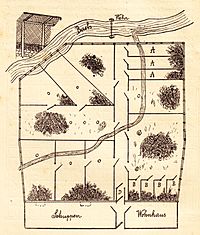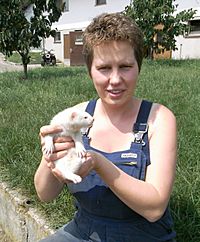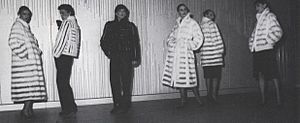Mink industry in Denmark facts for kids
Denmark used to be the world's largest producer of mink furs. The country produced about 40 percent of all mink furs globally. These furs were a very important export for Denmark, bringing in around €500 million each year. Kopenhagen Fur, located in Copenhagen, was the biggest fur auction house in the world. It sold millions of Danish mink furs, along with furs from other countries. Danish mink furs were known for being very high quality.
However, in November 2020, a new type of COVID-19 was found in mink. This led the Danish government to order that all 17 million mink in the country be put down. This decision was made to stop the virus from spreading and causing more problems. This event brought an end to the mink farming industry in Denmark.
Contents
The History of Mink Farming in Denmark
American mink were first brought to Denmark for farming in the mid-1920s. Before this, there were no mink farms in Denmark. By the mid-1980s, Denmark had become the second-largest mink producer, right after the United States. In 1983, Denmark produced 8.3 million furs, which was 22 percent of all furs made worldwide. By 2002, this number grew to 12.2 million furs, making up almost 40 percent of the world's total. The fur trade was considered a very important part of Denmark's economy.
COVID-19 and the End of Mink Farming
In November 2020, a new version of COVID-19 was discovered in mink. This new version was called "cluster 5." Scientists were worried that this mutated virus could spread from mink to humans and cause the global pandemic to get worse. Because of this concern, the Danish government made a difficult decision. They ordered that all 17 million mink in Denmark be culled, meaning they had to be put down.
At least 12 people were infected with this mink-related virus strain. The government announced that all mink would be culled by November 16, 2020. Later, it was found that the order to cull all mink, not just those in infected areas, was not legal at the time it was given. The Prime Minister, Mette Frederiksen, admitted this. The Minister for Agriculture, Mogens Jensen, resigned from his position. Later, a special law was passed to make the government's order legal after it had happened.
On December 20, 2020, the Danish Parliament passed a law to ban mink farming in Denmark until 2022. This effectively ended the large mink industry in the country.
How Mink Were Raised on Farms
Denmark's weather, with its mild winters and cool summers, was perfect for raising animals like mink that have fur. Fish waste from Denmark's large fishing industry was used to feed the mink on farms. A typical Danish mink farm could have as many as 13,000 cages. These cages were set up in long rows, often 60 meters long. Each cage usually housed two to four mink.
Inside the cages, there were special nesting boxes. Female mink would give birth to their babies, usually about five at a time, in these nesting boxes. They would also feed their young there. Farmers used computers and special systems to manage their mink herds. This helped them keep track of the animals and improve the breeding process.
Kopenhagen Fur worked like a cooperative for the farmers. Kopenhagen Fur also worked with the Danish Animal Welfare Society to make sure mink were raised in good conditions. They created rules for mink farming that were approved by the government in 2007. Danish fur farms produced about 15.6 million mink each year. While some farms were very large, many smaller, family-run farms also existed.
Selling Danish Mink Furs
Mink furs from Denmark were sold almost entirely through auctions at Kopenhagen Fur. These auctions happened five times a year. The first auction took place in December, after the new furs were ready. The last auction was usually in September. Each auction typically sold furs worth about 260 million euros and lasted for five days.
The main countries that bought Danish mink furs were China, Hong Kong, Japan, and Korea. At an auction in December 2012, there were 500 buyers. About 85 percent of the furs were bought by customers from China. Around 2012, the average price for one mink fur was 582 Danish crowns (about US$100). This was the highest price ever recorded at Kopenhagen Fur at that time.





